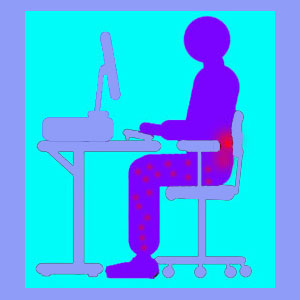
Tingling legs is one of the most common symptomatic expressions of sciatica. Tingling is also commonly described as the feeling of pins and needles and may occur in virtually any area of one or both legs. The 2 most common regions are the entire side of the leg from the knee to the ankle and the entire back of the leg from the thigh to the calf. There are many possible explanations for sciatica-related tingling in the legs, ankles or feet, but one thing is for sure; it is always a burden for any patient to endure, especially when accompanied by chronic pain.
This article provides an in-depth look at paresthesia in the legs related to sciatic nerve problems. We will discuss the many possible causes of leg tingling, including spinal, nonspinal and nonstructural sources.
Spinal Causes of Tingling Legs
The usual diagnoses involving the spine and tingling in the lower body include lumbar spinal stenosis and especially foraminal stenosis leading to a pinched nerve. Both of these conditions can be caused by a herniated disc or bone spur complex, among other spinal abnormalities.
While it is certainly possible for foraminal or lumbar central stenosis to cause pain, tingling, numbness and weakness in the lower body, these conditions are usually easily diagnosed and treated. This is because nerve conduction testing can identify which nerve root is affected and then the symptoms can be correlated to the diagnosis to be sure that the source process is indeed correct before therapy begins.
However, proper neurological evaluation is not always completed and many cases of nerve root compression are clearly speculative, at best. The most common indicator of a misdiagnosed pinched nerve is a lack of corresponding symptoms. In a few patients, the symptoms are too narrowly defined, while in most, the symptoms are too broad and overly involved.
Central spinal stenosis above the lumbar region actually has the chance of compressing the spinal cord. This is a far more unpredictable condition and the symptoms may be difficult to correlate by location, expression or severity, since each symptomatic profile is unique and may even change within the same patient regularly.
Non-Spinal Causes of Tingling
Non-spinal diagnostic sources of leg tingling include sacroiliac joint issues and piriformis syndrome. Both of these conditions are becoming far more prevalent in the medical system, which is rather ironic, since the SI joint is one of the strongest and best designed in the entire body and piriformis syndrome is not even proven to exist in the vast majority of diagnosed individuals.
One of the least commonly diagnosed conditions is also one of the more usual actual reasons for chronic sciatica. This condition is simple oxygen deprivation of the spinal nerve roots or the sciatic nerve, which can cause a variety of symptoms, including tingling and the other usual suspects of sciatica. It is because of the vast numbers of unresponsive ischemic lower back and leg pain conditions that sciatica has developed such a fierce and treatment-resistant reputation.
Leg tingling can also result from less typically seen injurious, systemic and disease processes, such as tumor formation, cyst formation, localized trauma, diabetes, circulatory issues and a variety of general neuropathy conditions.
Guidance on Tingling Legs
Tingling can be scary due to its association with sensitive neurological tissues. If a spinal causation is indeed the source, medical treatment may be needed.
For cases of rare, but actual sacroiliac joint concerns, medical and sometimes surgical intervention is advised. Just let it be known that most SI joint syndromes do not cause such widespread symptoms to exist far down the leg. Instead, most are confined to the area immediately near the SI joint.
However, just be aware that most cases of sciatica are not clearly explainable and some are misdiagnosed. Make sure to research the facts about sciatica for yourself, especially before even thinking about any drastic or surgical therapy.
Remember that sciatica defies treatment for a real reason. It is not the tenacity of the pain itself. It is usually simply an incorrect diagnosis.





